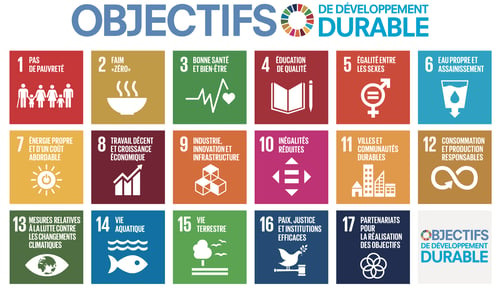Measure & Reduce your Company's Carbon Footprint
What is a carbon footprint?
Carbon assessment or GHG assessment definition
A carbon footprint assessment or a GHG assessment, quantifies all the greenhouse gas (GHG) emissions an organization has generated over a year. This accounting exercise follows the GHG Protocol, a methodology developed by the World Resources Institute (WRI) and the World Business Council for Sustainable Development (WBCSD).
For a company, measuring its carbon footprint is the first step of a meaningful environmental journey.
Progressively, more and more companies are integrating a strong environmental approach, whether to anticipate future regulations or to show that they are committed to the fight against global warming.
Why measure your carbon footprint?
-
To take responsibility for the environment: At the global level, companies have a responsibility to address climate change. The Intergovernmental Panel on Climate Change (IPCC) warns of the impact of global warming on our civilizations. To limit warming to 1.5 degrees above pre-industrial levels, as set out in the Paris Agreement, individuals and businesses must take the necessary steps to reduce their emissions and contribute to global carbon neutrality.
-
To maintain its performance: From a company performance perspective, addressing climate issues is central. Indeed, the more a company is exposed to climate risks or depends on energy resources subject to price fluctuations and supply difficulties, the more it is vulnerable to the consequences of climate variability on its profitability.
-
To comply with regulations: Finally, more and more companies are measuring their carbon footprint because they are targeted by increasing environmental regulations at both European and national levels.
→ There are however other reasons why they have an interest to calculate their carbon footprint.
As we have highlighted, it is impossible to develop an effective reduction plan without first determining the quantity and causes of the CO2 emissions in question. The first step, therefore, is to identify one's own emission sources to be able to reduce them. Once identified, there are a multitude of actions that can reduce a company's environmental impact.
Who has to measure its carbon footprint?
The CSRD, a new European directive, significantly expands the scope of mandatory non-financial reporting within the EU. It applies to a wide range of European and non-European companies and will be implemented gradually between 2024 and 2028, depending on the category of the company. This directive represents a key step in integrating environmental and human rights issues at the core of business requirements and long-term sustainability.
Contact ClimateSeed to learn more about conducting your carbon footprint assessment and the regulatory developments that may affect you!
How to measure a carbon assessment?
To conduct a carbon assessment, it is necessary to choose a methodology, define the scope for measuring the carbon footprint, understand what data needs to be collected, and know how to convert it into greenhouse gas emissions.
What methodology to choose for measuring the carbon footprint?
There are two main methodologies for measuring a company's carbon footprint:
GHG Protocol
The most widely used and internationally recognized method, was developed in 1998 by the World Business Council For Sustainable Development (WBCSD) and the World Resources Institute (WRI). It accounts for emissions from six main greenhouse gases (Carbon Dioxide (CO2), Methane (CH4), Hydrofluorocarbons (HFCs), Nitrous Oxide (N2O), Perfluorocarbons (PFCs), and Sulfur Hexafluoride (SF6)). The GHG Protocol categorizes emissions into three Scopes.
Bilan GES (or French Regulatory GHG Inventory)
A French methodology that divides emission categories into six parts:
1️⃣ Direct GES emissions
2️⃣ Indirect emissions associated with energy
3️⃣ Indirect emissions associated with transport
4️⃣ Indirect emissions associated with purchased products
5️⃣ Indirect emissions associated with sold products
6️⃣ Other indirect emissions
The choice of methodology depends on the organization's needs, the Scope they wish to include in their inventory, and how they want to use the results.
At ClimateSeed, our SaaS solution is fully compliant with French and international standards (Regulatory GHG Report, GHG Protocol Corporate Standard). To find out more, click here.
Perimeters to consider
Three Scopes must be considered for a carbon assessment, determining what emissions will be included in the measurement. Setting these perimeters helps to determine which emissions will be considered in the measurement.
In other words, it is necessary to define what the company wishes to include and set the limits of the analysis.
The 3 perimeters mentioned above are:
Temporal Scope: This corresponds to the period over which the company wishes to measure its carbon footprint, typically the previous 12 months to have all the necessary data.
Organizational Scope: This includes the different sites, installations, and buildings to be considered. For example, does the company want to measure the carbon footprint of its sites in multiple countries?
Operational Scope: This relates to the emission categories linked to these sites, installations, and buildings. Different methodologies usually categorize emission categories into three Scopes.
What type of data should be collected? The example of Scopes 1, 2 & 3 of the GHG Protocol
GHG emissions are categorized into different emission items with 3 Scopes.
Scope 1: Direct emissions related to the company's activities, such as emissions from the company-owned vehicle fleet or industrial processes.
Scope 2: Indirect emissions caused by the company's purchase of energy, typically in the form of electricity, heat, or steam.
Scope 3: Indirect emissions from activities external to the company's operations, including emissions from purchased goods and services (including the fuel emitted for their transport), waste management, employee commuting, business travel, etc.
Collecting data for Scope 3 emissions is the most complex, as it comes from sources outside the company's control. It often requires involving multiple stakeholders. Scope 3 emissions are significant, sometimes representing up to 90% of a company's carbon footprint.
Once the operational Scope is determined, data related to the company's various emission sources must be collected over a specific time period (usually a year) using either a physical or monetary approach.
Figure 1 : Scopes 1, 2 & 3 ©ClimateSeed
Collecting data for Scope 3 emissions is the most challenging part of a carbon assessment, as these data come from sources outside the company's control. It requires the involvement of multiple stakeholders. However, Scope 3 emissions should not be overlooked, as they often represent a significant portion of a company's carbon footprint, sometimes up to 90%.
Once the operational Scope is determined, data related to the company's various emission sources must be gathered. These data should be collected over a specific period (usually a year) and can be collected using two different approaches: the monetary approach and the physical approach.
Data Collection: Physical and Monetary Approaches
There are two approaches to collecting a company's activity data: the physical approach and the monetary approach. Both convert the company's activity data into equivalent CO2 tons.
|
Physical approach |
All other data that are collected through intuitive and collaborative input (for example, a number of kilometers). |
|
Monetary approach |
Activity data gathered from the company's financial or accounting data (for example, an amount in Euros). These data are generally grouped in the general ledger. |
These two approaches complement each other: the purchase of services can generally only be treated using monetary ratios; however, these ratios are not relevant for accounting for emissions from an airplane trip where the cost is not proportional to the distance.
Once the data are collected, they must be used to create a carbon assessment.
How to convert Data into Greenhouse Gas Emissions?
To calculate GHG emissions associated with each business activity, the data collected must be converted using what is called an emission factor.
An emissions factor is a representative value that converts the collected activity data into greenhouse gas emissions.The calculation is as follows:
Data x emission factor = Greenhouse Gas emissions
These emission factors are available in public or private databases, often specific to a country or sector of activity (e.g., DEFRA, EcoInvent, IAE, or Base Carbone® in France).
It is important to note that emission factors can vary from one country to another; for example, the factor related to electricity varies depending on the energy mix of the country. Therefore, the location of the company must be considered when measuring its carbon footprint.
Can my company measure GHG emissions on its own?
A company can decide to measure its carbon footprint internally or outsource the task to a specialized service provider.
It is advisable to work with experts to ensure the accuracy and veracity of the results and to obtain reports verified by a trusted third party, usable by investors and customers. Outsourcing the measurement minimizes reputational risks and accusations of greenwashing. Additionally, consultants, with their experience, are more likely to guide a company in its reduction actions and, therefore, its decarbonization.
Decarbonizing your business
My company has completed its GHG assessment. What happens next?
Once the carbon assessment is finalized, it’s analyzed to identify reduction priorities, meaning efforts are focused on reducing greenhouse gas (GHG) emissions. These potential levers of action will help develop a reduction plan.
A question then arises: how to establish an effective reduction plan that is compatible with your company’s activity and budget? Several criteria, such as the percentage of GHG emissions to reduce, the scopes to target, and the timeframe for action, should be considered in this plan. At ClimateSeed, our consultants are available to define these priority criteria.
But before establishing a plan, it's important to set a goal!
Setting a goal for your company
For a company, setting a clear and precise reduction goal and actions is crucial but can be complex. To effectively define reduction objectives, the SBT initiative (or SBTi) has developed what are called "science-based targets." These are GHG emission reduction trajectory recommendations that are quantifiable, measurable in the long term, and aligned with the latest climate science.
They are based on the 2015 Paris Agreement, aiming to limit global warming to +1.5°C compared to the pre-industrial era. (Note: Alignments lower than +2°C are no longer accepted since June 2022).
They are defined based on several parameters:
-
Duration of application: For medium-term science-based targets, reduction goals must be achieved by 2030. For Net-zero targets, formerly long-term science-based targets, they must be achieved by 2050. A company’s Net-zero target is the aggregation of its long-term science-based targets.
-
Scope of emissions: For scopes 1 and 2, medium-term science-based targets should cover 95% of emissions by 2030. For scope 3, two-thirds of emissions should be covered by 2030.
Now that the goal is set, a strategy to achieve it needs to be established.
How to determine your action plan?
The environmental strategy of companies usually follows the "Measure, Reduce, Contribute" scheme (NB: it is now preferable to use the term "contributing" instead of "offsetting"). Carbon contribution involves financing emission reduction projects (e.g., forest and soil management, installation of renewable energy sources) beyond their value chain. This triad enables the company to participate in global carbon neutrality.
To define this plan, the following steps are necessary:
- Co-construction of the action plan with your stakeholders who are best placed to know the business and what is feasible, both from a governance and technical standpoint. This is measured in terms of:
➡️ GHG Emission Significance: Does my action allow for a significant reduction?
➡️ Ease of Action: Does my action require significant investment (in terms of governance, technique, costs)?
Figure 2 : How do you prioritize your reduction actions?
Source : ClimateSeed
➡️ Precise quantification of reduction actions, considering their potential interdependence.
➡️ Planning the implementation (with determination of a schedule, a responsible person, tracking indicators, etc.).
➡️ Implementation, possibly with adjustment of the strategy and objectives as progress is made.
Taking action & documenting reduction actions
When a company undertakes concrete actions, it's important to document them. This process is necessary for several reasons:
- To evaluate and monitor performance in terms of reduction compared to the predefined reduction trajectory.
- To adjust reduction actions if they are insufficient to achieve the desired trajectory.
- To demonstrate a high degree of transparency to stakeholders (investors and customers increasingly pay attention to this aspect).
When working with experienced consultants (like those available at ClimateSeed), it's imperative to demand an official report detailing (1) how GHG emissions were calculated, (2) the planned reduction trajectory, and (3) the completion schedule for the objectives.
This document can then be used to communicate with your investors, customers, and regulating authorities.
In addition to official reports, specialized NGOs have also set up initiatives that allow you to report (and get rated for) your own climate action.
The SBT Initiative Dashboard (SBTi)
The SBT initiative allows companies committed to it to have their reduction actions tracked and available online for all to see. If the SBT initiative validates the company's reduction goal, it will closely monitor its progress towards achieving it.
On the SBTi website, there's a summary dashboard that visualizes companies that have committed, those that have set science-based targets, and those that have already achieved some of their goals.
The CDP Climate Change Questionnaire
The CDP (formerly Carbon Disclosure Project) aims to increase the precision and transparency of information related to GHG emissions and the environmental impact of companies and public institutions.
Through its Climate Change Questionnaire, the CDP collects information on organizations' impacts. It then stores this information in their environmental database (one of the largest in the world!) and discloses it online. This encourages companies and public institutions to further commit to climate action.
The CDP Scoring
More recently, the CDP has implemented a simpler scoring system.
Following the same logic as the Nutri-score, the CDP has established a scoring system to rate the environmental impact of companies and state organizations.
Scores range from D to A, with an additional F score for companies that initially responded but ultimately refused to comply with the exercise. This score summarizes the company's environmental positioning.
Our consultants are available if you wish to perform a simulation of your company’s rating.
To decarbonize business activities, it’s essential to define reduction objectives, a plan to achieve them, and document the results.
The European Union's CSRD Directive
The CSRD applies to a wide range of European and non-European companies, with its implementation being phased in progressively from 2024 to 2028, depending on the category of the company.
Specifically, it will be applied in several phases:
- Starting in 2024, for large companies already subject to the NFRD.
- From 2025, for all other large European companies and certain international groups.
- From 2026, for SMEs listed on European markets.
- From 2028, for large non-European companies with significant operations in Europe.
Companies will thus benefit from a 1 to 3-year transition period, depending on their size and status, to help them adapt to these new requirements.
For more details, read our dedicated article.
How ClimateSeed can help your company to calculate its carbon footprint?
ClimateSeed can help you measure and reduce your carbon footprint (GHG footprint). We provide a digital tool to measure and reduce your carbon footprint in line with GHG accounting standards (GHG Protocol and BEGES) and scientific objectives (SBTi). In addition to our platform, our low-carbon strategy experts can guide you through the process.
The main sectors we cover are: pharmaceuticals, hotels, luxury goods, transport, events, banking, cosmetics, textiles and services. Since our launch in 2018, 200 organizations have placed their trust in us.
Measuring your carbon footprint is the first step to a successful environmental approach.
To discover our offers, click here.
What can be done to go further?
Contributing to Certified Emission Reduction Projects
To support the goal of global carbon neutrality, the IPCC indicates that it is important for an organization to establish a parallel between:
- Reducing its emissions in its value chain
- Contributing to avoidance projects
(Source: IPCC)
To amplify its positive impact and reinforce its commitment against climate change, a company can decide to contribute to carbon sequestration or avoidance projects.
To do this, companies purchase carbon credits generated by these projects. One carbon credit is equivalent to one ton of carbon avoided or sequestered.
To ensure the positive impact of a project, it's important to verify that the selected project is validated by an international or national standard and that it is not a source of criticism or controversy.
There are different types of projects. The most common are forest conservation and soil management projects.
Beyond positive environmental impacts, these projects also have co-benefits, as they contribute to the United Nations' Sustainable Development Goals, which promote gender equality, access to education, health care, etc.

For more information on carbon contribution and to better understand which project to select, access our dedicated guide on the subject.
Involving Stakeholders
For more persistent and impactful climate action, it is fundamental to involve your stakeholders in your environmental approach.
Awareness is key to encouraging a behavior change among employees, suppliers, etc. It is necessary to inform collaborators about climate issues, train them on reduction solutions and preferred approaches, and regularly mobilize them.
This mobilization can be done, for example, through interactive workshops such as the climate collage, available in various themes, or through training.
The greater the involvement and awareness of stakeholders (especially employees), the more they will be encouraged to change their choices and participate in the company's reduction actions, for example, related to the canteen, transportation methods, and waste sorting.
Internal and External Communication
The way a company communicates about its climate action can greatly influence its perception by various stakeholders.
Internally, it is very important to communicate well to involve collaborators. For example, highlight the different actions implemented to encourage their use (a bike park, recycling bins, etc.).
Externally, to avoid any allegations of greenwashing, companies must communicate transparently and in detail about their approach. They should explain the source of their emissions, detail their commitments with realistic numerical values, and the actions to be implemented. Tracking the progress of reduction actions or difficulties encountered year by year also demonstrates great transparency.
Furthermore, the terminologies used can also have an impact. For instance, a company cannot be carbon neutral at its level; it should be referred to as global-scale neutrality (ADEME). It is also preferable to talk about contribution instead of carbon offsetting. Please see our guide dedicated to this topic for more information.
Share this
You May Also Like
These Related Stories

Low-Carbon Transition Plan: Defining and Implementing your Corporate Strategy

The Corporate Net-Zero Standard by the SBTi

.webp?width=600&height=829&name=Download%20Guide%20measure%26reduction%20EN%20(1).webp)
